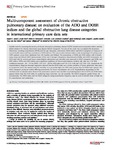Multi-component assessment of chronic obstructive pulmonary disease: an evaluation of the ADO and DOSE indices and the global obstructive lung disease categories in international primary care data sets
| dc.contributor.author | Jones, Rupert | |
| dc.contributor.author | Price, D | |
| dc.contributor.author | Chavannes, NH | |
| dc.contributor.author | Lee, AJ | |
| dc.contributor.author | Hyland, ME | |
| dc.contributor.author | Ställberg, B | |
| dc.contributor.author | Lisspers, K | |
| dc.contributor.author | Sundh, J | |
| dc.contributor.author | van der Molen, T | |
| dc.contributor.author | Tsiligianni, I | |
| dc.date.accessioned | 2016-08-10T08:26:24Z | |
| dc.date.available | 2016-08-10T08:26:24Z | |
| dc.date.issued | 2016-04-07 | |
| dc.identifier.issn | 2055-1010 | |
| dc.identifier.issn | 2055-1010 | |
| dc.identifier.other | 16010 | |
| dc.identifier.uri | http://hdl.handle.net/10026.1/5253 | |
| dc.description.abstract |
Suitable tools for assessing the severity of chronic obstructive pulmonary disease (COPD) include multi-component indices and the global initiative for chronic obstructive lung disease (GOLD) categories. The aim of this study was to evaluate the dyspnoea, obstruction, smoking, exacerbation (DOSE) and the age, dyspnoea, obstruction (ADO) indices and GOLD categories as measures of current health status and future outcomes in COPD patients. This was an observational cohort study comprising 5,114 primary care COPD patients across three databases from UK, Sweden and Holland. The associations of DOSE and ADO indices with (i) health status using the Clinical COPD Questionnaire (CCQ) and St George's Respiratory Questionnaire (SGRQ) and COPD Assessment test (CAT) and with (ii) current and future exacerbations, admissions and mortality were assessed in GOLD categories and DOSE and ADO indices. DOSE and ADO indices were significant predictors of future exacerbations: incident rate ratio was 1.52 (95% confidence intervals 1.46-1.57) for DOSE, 1.16 (1.12-1.20) for ADO index and 1.50 (1.33-1.68) and 1.23 (1.10-1.39), respectively, for hospitalisations. Negative binomial regression showed that the DOSE index was a better predictor of future admissions than were its component items. The hazard ratios for mortality were generally higher for ADO index groups than for DOSE index groups. The GOLD categories produced widely differing assessments for future exacerbation risk or for hospitalisation depending on the methods used to calculate them. None of the assessment systems were excellent at predicting future risk in COPD; the DOSE index appears better than the ADO index for predicting many outcomes, but not mortality. The GOLD categories predict future risk inconsistently. The DOSE index and the GOLD categories using exacerbation frequency may be used to identify those at high risk for exacerbations and admissions. | |
| dc.format.extent | 16010-16010 | |
| dc.format.medium | Electronic | |
| dc.language | en | |
| dc.language.iso | en | |
| dc.publisher | Springer Science and Business Media LLC | |
| dc.subject | Aged | |
| dc.subject | Cohort Studies | |
| dc.subject | Disease Progression | |
| dc.subject | Dyspnea | |
| dc.subject | Female | |
| dc.subject | Health Status | |
| dc.subject | Hospitalization | |
| dc.subject | Humans | |
| dc.subject | Male | |
| dc.subject | Middle Aged | |
| dc.subject | Netherlands | |
| dc.subject | Primary Health Care | |
| dc.subject | Prognosis | |
| dc.subject | Proportional Hazards Models | |
| dc.subject | Pulmonary Disease, Chronic Obstructive | |
| dc.subject | Severity of Illness Index | |
| dc.subject | Smoking | |
| dc.subject | Surveys and Questionnaires | |
| dc.subject | Sweden | |
| dc.subject | United Kingdom | |
| dc.title | Multi-component assessment of chronic obstructive pulmonary disease: an evaluation of the ADO and DOSE indices and the global obstructive lung disease categories in international primary care data sets | |
| dc.type | journal-article | |
| dc.type | Journal Article | |
| dc.type | Observational Study | |
| dc.type | Research Support, Non-U.S. Gov't | |
| plymouth.author-url | https://www.webofscience.com/api/gateway?GWVersion=2&SrcApp=PARTNER_APP&SrcAuth=LinksAMR&KeyUT=WOS:000375122000002&DestLinkType=FullRecord&DestApp=ALL_WOS&UsrCustomerID=11bb513d99f797142bcfeffcc58ea008 | |
| plymouth.issue | 1 | |
| plymouth.volume | 26 | |
| plymouth.publication-status | Published | |
| plymouth.journal | npj Primary Care Respiratory Medicine | |
| dc.identifier.doi | 10.1038/npjpcrm.2016.10 | |
| plymouth.organisational-group | /Plymouth | |
| plymouth.organisational-group | /Plymouth/Faculty of Health | |
| plymouth.organisational-group | /Plymouth/REF 2021 Researchers by UoA | |
| plymouth.organisational-group | /Plymouth/REF 2021 Researchers by UoA/UoA03 Allied Health Professions, Dentistry, Nursing and Pharmacy | |
| plymouth.organisational-group | /Plymouth/REF 2021 Researchers by UoA/UoA03 Allied Health Professions, Dentistry, Nursing and Pharmacy/UoA03 Allied Health Professions, Dentistry, Nursing and Pharmacy MANUAL | |
| plymouth.organisational-group | /Plymouth/Research Groups | |
| plymouth.organisational-group | /Plymouth/Research Groups/Centre for Brain, Cognition and Behaviour (CBCB) | |
| plymouth.organisational-group | /Plymouth/Research Groups/Centre for Brain, Cognition and Behaviour (CBCB)/Behaviour | |
| plymouth.organisational-group | /Plymouth/Research Groups/FoH - Community and Primary Care | |
| plymouth.organisational-group | /Plymouth/Research Groups/Institute of Health and Community | |
| plymouth.organisational-group | /Plymouth/Research Groups/Institute of Translational and Stratified Medicine (ITSMED) | |
| plymouth.organisational-group | /Plymouth/Research Groups/Institute of Translational and Stratified Medicine (ITSMED)/CCT&PS | |
| plymouth.organisational-group | /Plymouth/Users by role | |
| dc.publisher.place | England | |
| dcterms.dateAccepted | 2016-01-05 | |
| dc.identifier.eissn | 2055-1010 | |
| dc.rights.embargoperiod | No embargo | |
| rioxxterms.versionofrecord | 10.1038/npjpcrm.2016.10 | |
| rioxxterms.licenseref.uri | http://www.rioxx.net/licenses/all-rights-reserved | |
| rioxxterms.licenseref.startdate | 2016-04-07 | |
| rioxxterms.type | Journal Article/Review | |
| plymouth.oa-location | https://www.nature.com/articles/npjpcrm201610 |


